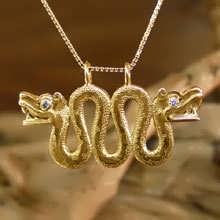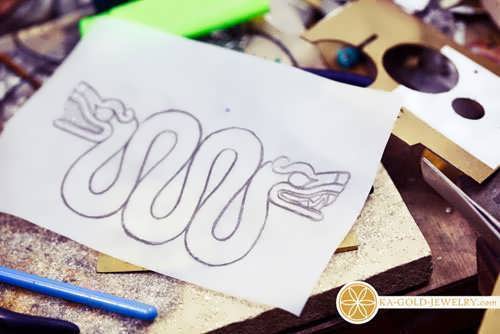
Double-Headed Serpent Gold
Powerful Symbol of Recreation, Healing and Rebirth
A constant reminder to the power within you to heal and to recreate yourself.
The Aztec Ouroboros - Double-Headed Serpent
The Double-headed serpent is the Aztec ancient symbol of the Ouroboros. In ancient times it was made as a statue, composed of mostly turquoise pieces applied to a wood base. It came from Aztec Mexico and might have been worn or displayed in religious ceremonies. It is possible that this sculpture may be one of the gifts given by the Aztec emperor, Moctezuma II, to Spanish conquistador Hernán Cortés when he invaded in 1519.
This symbol was so sacred and significant that an overwhelming amount of labor was put into making these statues covered in turquoise. The Aztecs didn’t use iron tools and had to cut the turquoise stones with harder stones, then, the stones have been broken into similar sized pieces and then stuck to the wooden body with pine resin. Using 2,000 small flat pieces stone that gives the impression of a smooth curved mosaic surface. It has to be remembered that Some of the turquoises had been brought 1,600 km to become part of this serpent!!!
Click here to read David's personal story with the Double Headed-Serpent

The Ouroboros is the ultimate symbol of renewal, creativity and endless change.
The Ouroboros symbol has accompanied me for many years and represents for me the courage to accept life-changing decisions.
The Ouroboros often represents self-reflexivity or cyclicality, especially in the sense of something constantly re-creating itself, the eternal return, and other processes perceived as cycles that begin anew as soon as they end. It can also represent the idea of unity. The Ouroboros has been important in religious and mythological symbolism but has also been frequently used in alchemical illustrations, where it symbolizes the circular nature of the alchemist's opus.
The Ouroboros symbolizes on a personal level the ability to create ourselves a new and to inspire us to make long-lasting changes in our lives. On the cosmic level, it is the symbol of the universe itself that creates itself a new from itself, or as Stephen Hawking says - The force of gravity that allows, in fact, the universe to create itself a new infinitely.
One of the most surprising places where I encountered this symbol in its deepest personal meaning is with Neil Peart, The drummer for Rush. Peart is a well-known musician and one of the world’s greatest drummers. His intelligent lyrics as well, as his complex rhythm pieces on the drums, led to him being called “The Professor”. One day while searching online for auto parts for a vintage car I ran into a blog on motorcycles.
One of the songs from the album “Moving Pictures”, is called "Red Barchetta". The song is based on a story written by a young student for a car magazine in 1973 and describes a future where government regulations cause the extinction of old cars in favor of awkward vehicles without any joy of the driving experience. The song was a metaphor for a society that compels the creative individual to surrender to its mediocrity. For years Neil looked for the author of the story to no avail until he eventually found him and invited him on a motorcycle trek that is documented in the blog.
Only later did I discover that in 1997 he lost his only daughter in a car accident and then his wife ten months later to cancer. As a result of the tragedy, he set out on a motorcycle trek throughout north and central America, where he covered a distance of 55000 miles as a journey of self-healing. In the end, he returned to the band and while I was watching their concert recently I noticed that his entire drum kit and the stage was covered with the Ouroboros symbol…